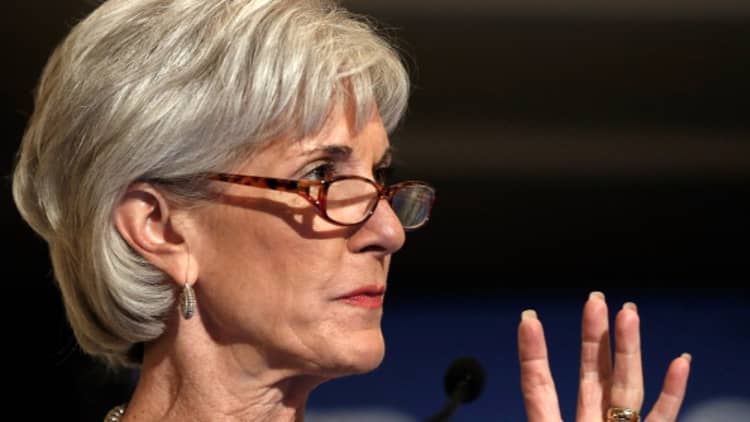Filling a prescription is pretty simple. In some states, including Maine, Minnesota and New York, your doctor electronically files the order. Elsewhere you bring the doctor’s scribbled instructions to a pharmacist.
Except that maybe it’s not so simple. Maybe there is a cheaper medication available that would do the same job. In that case, why doesn’t your pharmacist tell you?
Because in many states, your pharmacist operates under a contract that forbids telling you about less expensive alternatives.
“Every time a pharmacist dispenses a medication, they know a lot about other medications for sale that aren’t necessarily related to that person’s health plan,” said Shawn Bishop, vice president of programs that control health care costs and advance Medicare at the Commonwealth Fund. (The Commonwealth Fund is a health care policy research organization.)
Except for generics, pharmacists are not allowed to consult on other available products.Shawn Bishopvice president, Commonwealth Fund
Bishop compares buying a prescription drug to shopping for a sweetener.
“You can use a brand name like Domino sugar, or the supermarket’s house brand, which is a bit cheaper,” she said. “You could use stevia or another sugar substitute.”
Just imagine, though, that your supermarket steers you only to the name brand without mentioning any of the options.
“Pharmacists are the experts on these medications,” Bishop said. “They’re trained in the chemical properties of drugs and their interactions.”
Generics help cut costs
The explosion in generic drugs — now at about a 90 percent dispensing rate — came in the wake of the 1984 Hatch-Waxman Act, Bishop explains, which was intended to encourage the manufacture of generic drugs.
“It literally went from 20 percent or so in the 1980s,” Bishop said.
But the language in some contracts prevents pharmacists from mentioning these alternatives. “Except for generics, pharmacists are not allowed to consult on other available products,” Bishop said.
Sometimes called “gag rules,” contracts between pharmacists and pharmacy benefit managers — who work on behalf of your company's health plan — use boilerplate language to prevent a pharmacist discussing lower-cost alternatives.
The benefit manager creates the formulary of drugs on the health plan, usually in three cost tiers. The conflict arises when the benefit manager gets a rebate on brand-name drugs, said Bishop.

Tiered copayment can help rein in drug costs, but sometimes a copay is higher than the cash cost of the drug, according to Bishop. The rebates are cause for concern.
“Every time you have a rebate, there should be some raised eyebrows,” Bishop said. “There is a conflict when you get a rebate from the manufacturer.”
This conflict caught the attention of the Trump administration, which issued in May a blueprint to lower drug prices. The memo targets drug companies for keeping lower-cost drugs out of the market and cites the lack of transparency in drug-pricing benefits, among other issues.
Ask your pharmacist
Consumers need to learn to ask questions when they have their prescriptions refilled, Bishop says. Ask for lower-cost alternatives, even if they aren’t related to the consumer’s plan.
Mark Merritt, president of the Pharmaceutical Care Management Association, which represents America’s pharmacy benefit managers, says the association is opposed to these contractual clauses.
The PCMA says in a statement it supports the patient always paying the lowest cost at the pharmacy counter, whether the cash price or the copay. “This is standard industry practice in both Medicare and the commercial sector,” the organization said.
Make sure you understand your pharmacy benefit and your insurance plan.Mark MerrittPCMA president
Merritt recommends three strategies to get the lowest prescription prices. “First, make sure you understand your pharmacy benefit and your insurance plan,” Merritt said.
People aren’t always aware that different drugstores may charge different prices, and that goes for copays, too. “Always shop around,” Merritt said.
Next, talk with your physician about your prescriptions to make sure you are taking the most affordable drug, and that your prescriptions don’t duplicate each other.
If you’ve been on a drug for many years, generics or other suitable drugs may have come onto the market, Merritt says.
You can also consider home delivery.
“Often that is much less expensive and (people) can save three trips to the drugstore,” Merritt said. Home delivery orders generally offer a 90-day supply.
Seniors who use Medicare’s most popular plans use preferred pharmacy networks, Merritt says, another way to save money. These are discount pharmacy networks that yield bigger savings when you go to specific stores that have discount drugs for a plan.
More from Personal Finance:
Taking a drug to prevent AIDS could nix chances of getting disability insurance

